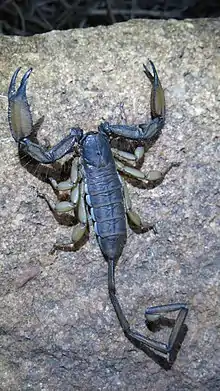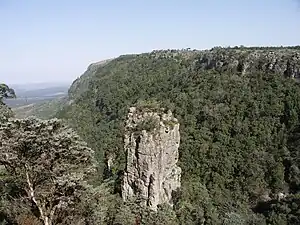| Hadogenes bicolor | |
|---|---|
 | |
| Scientific classification | |
| Domain: | Eukaryota |
| Kingdom: | Animalia |
| Phylum: | Arthropoda |
| Subphylum: | Chelicerata |
| Class: | Arachnida |
| Order: | Scorpiones |
| Family: | Hemiscorpiidae |
| Genus: | Hadogenes |
| Species: | H. bicolor |
| Binomial name | |
| Hadogenes bicolor Purcell, 1899 | |
Hadogenes bicolor is a species of scorpion endemic to South Africa. This species is often confused with H. troglodytes.
Description
The legs, tail and chelicerae of H. bicolor are paler than the carapace, forming a marked color contrast.[1] The overall appearance is consistent with that of the other members of Hadogenes, the body construction is flattened which allows them to navigate safely in and out the cracks and crevices that comprise their habitats.[2]
Distribution and ecology

Hadogenes bicolor is endemic to Mpumalanga and Limpopo provinces, South Africa.[1] It lives only in rocky outcrops along the Drakensberg escarpment at altitudes of 1,200–2,000 metres (3,900–6,600 ft). It lives in crevices in dolerite and granite rocks in areas with an annual rainfall of 600–1,100 millimetres (24–43 in).[1]
Taxonomy
Hadogenes bicolor was first described by W. F. Purcell in 1899, based on material collected by the Reverend J. W. Daneel "about twenty miles east of Pietersburg [now Polokwane], Zoutpansberg Distr., Transvaal".[3] The name Hadogenes bicolor has previously been used to cover animals now recognised as three separate species, H. bicolor, H. longimanus and H. newlandsi.[1] Many of the scorpions sold in the pet trade as H. bicolor are actually H. troglodytes.[1]
References
- 1 2 3 4 5 Lorenzo Prendini (2001). "Two new species of Hadogenes (Scorpiones, Tschnuridae) from South Africa, with a redescription of Hadogenes bicolor and a discussion on the phylogenetic position of Hadogenes" (PDF). Journal of Arachnology. 29 (2): 146–172. doi:10.1636/0161-8202(2001)029[0146:TNSOHS]2.0.CO;2. S2CID 84442985.
- ↑ Cook, Robert B. (2020-06-10). "Minerals and Gemstones of East Africa by Bruce Cairncross. Strunk Nature–Penguin Random House of South Africa; www.penguinrandomhouse.co.za. 144 pages; 2019; R250 (softbound)". Rocks & Minerals. 95 (4): 381. doi:10.1080/00357529.2020.1759357. ISSN 0035-7529. S2CID 221061858.
- ↑ W. F. Purcell (1899). "New South African scorpions in the collection of the South African Museum". Annals of the South African Museum. 1: 433–438.